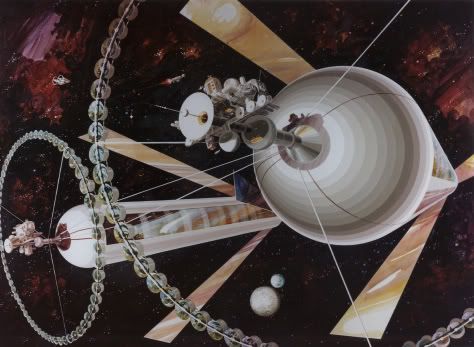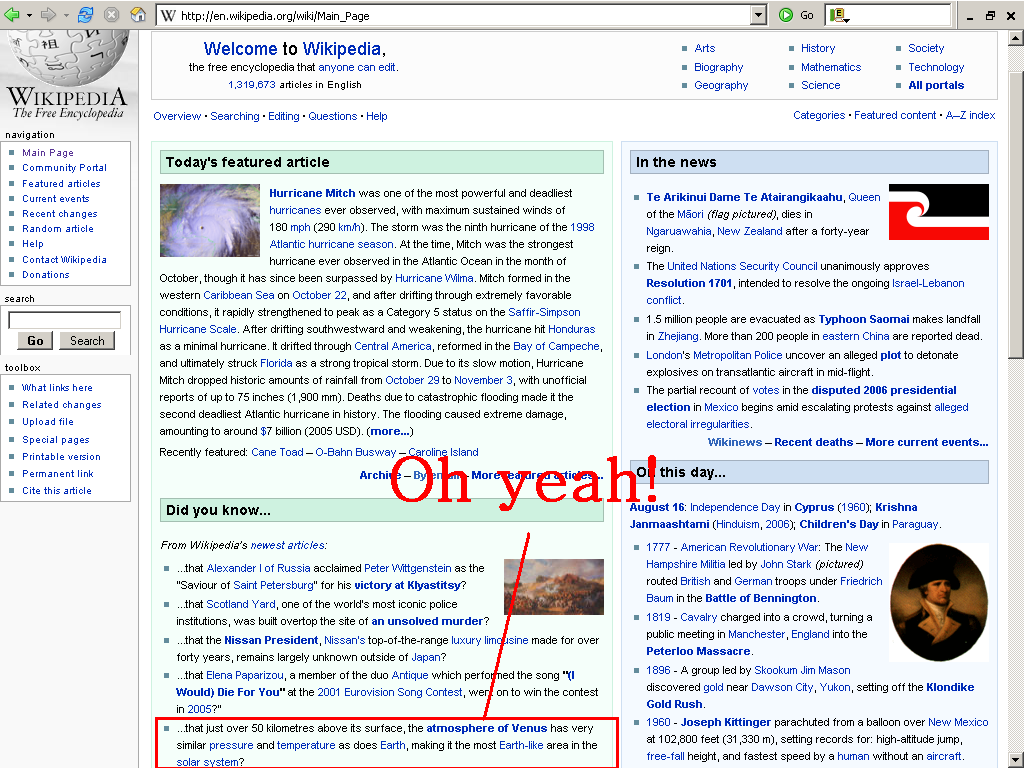

|
Korean Job Discussion Forums
"The Internet's Meeting Place for ESL/EFL Teachers from Around the World!"
|
| View previous topic :: View next topic |
| Author |
Message |
mithridates

Joined: 03 Mar 2003
Location: President's office, Korean Space Agency
|
 Posted: Mon Aug 07, 2006 7:59 am Post subject: Colonization of Venus Posted: Mon Aug 07, 2006 7:59 am Post subject: Colonization of Venus |
 |
|
I touched on this on the other thread but since it's a pdf and a little bit long for the casual thread-watcher I'm starting a new one. I had read before about Venus being around the same temperature as Earth when you get 50 km above the surface but I didn't know about breathable air being a lifting gas (like helium but half the lifting power) or that the pressure at that level is exactly the same. Plus Venus is closer to Mars so I say we give up on Mars and go to Venus. Here's the paper, and I'm going to put certain things in bold a la igotthisguitar, but hopefully they'll just be important parts. Here goes:
Conference on Human Space Exploration, Space Technology & Applications International Forum,
Albuquerque NM, Feb. 2-6 2003.
Colonization of Venus
Geoffrey A. Landis
NASA John Glenn Research Center, mailstop 302-1, 21000 Brook Park Road, Cleveland, OH 44135
216-433-2238 e-mail: [email protected]
| Quote: |
Abstract. Although the surface of Venus is an extremely hostile environment, at about 50 kilometers above the
surface the atmosphere of Venus is the most earthlike environment (other than Earth itself) in the solar system. It is
proposed here that in the near term, human exploration of Venus could take place from aerostat vehicles in the
atmosphere, and that in the long term, permanent settlements could be made in the form of cities designed to float at
about fifty kilometer altitude in the atmosphere of Venus. |
| Quote: |
INTRODUCTION
Since Gerard K. O�Neill (1974, 1976) first did a detailed analysis of the concept of a self-sufficient space colony, the
concept of a human colony that is not located on the surface of a planet has been a major topic of discussion in the
space community. There are many possible economic justifications for such a space colony, including use as living
quarters for a factory producing industrial products (such as solar power satellites) in space, and as a staging point
for asteroid mining (Lewis 1997). However, while the concept has focussed on the idea of colonies in free space,
there are several disadvantages in colonizing empty space. Space is short on most of the raw materials needed to
sustain human life, and most particularly in the elements oxygen, hydrogen, carbon, and nitrogen. Oxygen could be
imported from a rocky source, such as .the lunar surface, but the volatile materials hydrogen, carbon, and nitrogen
form primarily volatile materials that are not present in abundance on the lunar surface. Furthermore, for optimum
performance, human beings require gravity-- it requires major engineering structures to simulate (via rotation) the
presence of gravity in a free-space colony.
Even for colonizing the asteroids, it is not clear that a free space base is the optimum location: any given asteroid is,
on the average, rather distant from all the other ones, both in actual distance and in terms of the propulsion delta-V
required to get there.
An alternate possibility is to locate a colony on the surface of another planet. Most recently, the case for colonizing
the surface of Mars has been argued by Zubrin (1996). However, at least compared to the benign environment of
Earth, the surface of Mars has several disadvantages. It has a low atmospheric pressure, low temperatures, and high
exposure to cosmic radiation, and, while it is not a zero-gravity environment, it is not yet known whether the
roughly one-third Earth-normal gravity of Mars is sufficient to avoid the bone decalcification and muscle tone loss
experienced by astronauts in microgravity.
So let�s colonize Venus.
VENUS EXPLORATION
In many ways Venus is the hell planet. Results of spacecraft investigation of the surface and atmosphere of Venus
are summarized by Fimmel, Colin, and Burgess (1983) and by Bougher, Hunten, and Phillips (1997):
� Surface temperature 735K: lead, tin, and zinc melt at surface, with hot spots in excess of 975 K
� Atmospheric pressure 96 Bar (1300 PSI); similar to pressure at a depth of a kilometer under the ocean
� The surface is cloud covered; with little or no solar energy
� Poisonous atmosphere of primarily carbon dioxide, with nitrogen and clouds of sulfuric acid droplets.
However, viewed in a different way, the problem with Venus is merely that the ground level is too far below the one
atmosphere level. At cloud-top level, Venus is the paradise planet. As shown in figure 2, at an altitude slightly
above fifty km above the surface, the atmospheric pressure is equal to the Earth surface atmospheric pressure of 1
Bar. At this level, the environment of Venus is benign.
� above the clouds, there is abundant solar energy
� temperature is in the habitable "liquid water" range of 0-50C
� atmosphere contains the primary volatile elements required for life (Carbon, Hydrogen, Oxygen, Nitrogen,
and Sulfur)
� Gravity is 90% of the gravity at the surface of Earth.
While the atmosphere contains droplets of sulfuric acid, technology to avoid acid corrosion are well known, and
have been used by chemists for centuries.
In short, the atmosphere of Venus is most earthlike environment in the solar system. Although humans cannot
breathe the atmosphere, pressure vessels are not required to maintain one atmosphere of habitat pressure, and
pressure suits are not required for humans outside the habitat.
It is proposed here that in the near term, human exploration of Venus could take place from aerostat vehicles in the
atmosphere, and that in the long term, permanent settlements could be made in the form of cities designed to float at
about fifty kilometer altitude in the atmosphere of Venus.
Is Floating Difficult?
On Venus, breathable air (i.e., oxygen/nitrogen mixture at roughly 21:78 mixture ratio) is a lifting gas. The lifting
power of breathable air in the carbon dioxide atmosphere of Venus is about half kg per cubic meter. Since air is a
lifting gas on Venus: the entire lifting envelope of an aerostat can be breathable gas, allowing the full volume of the
aerostat to be habitable volume. For comparison, on Earth, helium lifts about one kg per cubic meter, so a given
volume of air on Venus will lift about half as much as the same volume of helium will lift on Earth.).
Science on Venus
Venus, the "greenhouse planet", is a scientifically fascinating place (Landis 2001, Landis et al. 2002). In many
ways it can be considered �Earth�s evil twin.� A huge number of important scientific questions need to be
answered:
� Before the runaway greenhouse effect, was early Venus temperate?
� Did Venus once have an ocean? If so, did it ever have life?
� What causes the geological resurfacing of the planet?
� What is the nature of the atmospheric superrotation?
� What are the aerosol particles in the atmosphere?
� What is the �snow� on Venus mountaintops?
� Can we learn about Earth�s climate from Venus?
� What is the nature of the disequilibrium chemistry in the Venusian atmosphere? Could it indicate
atmopsheric life?
At a temperature of 450 Celsius, and with 90 atmospheres of pressure of carbon-dioxide atmosphere, the surface of
Venus is far too hostile to land humans upon, but we can put humans in the atmosphere to explore the surface via
rugged telerobot.
Venus Telescience Technologies
In the telerobotic exploration scenario (Landis 2003), the humans remain in a habitat, and use teleoperation to rove
across the surface of Venus and explore. This requires a high-fidelity, high-bandwidth connection to give the
humans a fully-detailed virtual presence in the robotic body.
Humans participate in the exploration both by direct operation of the telerobots across a high-fidelity virtualpresence
link, and also by analyzing samples collected by the teleoperated robots in a fully-equipped on-site
laboratory. Because of the high wind velocity in the middle atmosphere of Venus, an atmospheric aerostat habitat
would not stay over the same surface location, but would constantly move. Although this would have some
disadvantages, such as requiring a relay station if long exploration of a single spot is required, it would also have
some advantages in constantly moving over new ground.
A robot to explore the surface of Venus will require new technologies; specifically, it will require electronics,
scientific instruments, power supplies, and mechanical linkages designed to operate at a temperature above 450
C�hot enough to melt the solder on a standard electronic circuit board. This will require devices made from
advanced semiconductor materials, such as silicon carbide, or even new approaches, such as micro-vacuum tube
electronics. Such materials are now being developed in the laboratory. In addition, for a fully immersive virtualreality,
high-bandwidth virtual-presence technologies will have to be developed, as well as highly capable
exploratory robotics.
While the human explorers could live in a habitat/laboratory in orbit around Venus, a better location for exploration
is an aerostat habitat. Teleoperation from the atmosphere allows near �real time� operation with minimum time
delay, giving a virtual presence on the surface. An atmospheric habitat has an advantage over an orbital habitat of
advantages of gravity (90% of Earth surface gravity) and atmospheric protection against cosmic radiation (same
equivalent mass as Earth�s atmosphere), and the presence of useful atmospheric gasses, including carbon dioxide and
nitrogen. Breathing oxygen for life support can be easily provided by separation of oxygen from atmospheric
carbon dioxide, either by zirconia electrolysis or by Sabatier processes.
So it should be possible to explore the surface of Venus remotely from an aerostat habitat. An atmospheric location
for the habitat has the addition advantage that it will be easy to bring samples up from the surface to be analyzed in
the habitat. The atmospheric pressure is high enough that both airplanes (Landis 2001) or balloons could lift
samples (assuming, of course, that the vehicles are adapted for high-temperature and pressure operation).
SETTLING VENUS
In the long term, permanent settlements could be made in the form of cities designed to float at about fifty kilometer
altitude in the atmosphere of Venus.
The thick atmosphere provides about one kilogram per square centimeter of mass shielding from galactic cosmic
radiation and from solar particle event radiation, eliminating a key difficulty in many other proposed space
settlement locations. The gravity, slightly under one Earth gravity, is likely to be sufficient to prevent the adverse
affects of microgravity. At roughly one atmosphere of pressure, a habitat in the atmosphere will not require a highstrength
pressure vessel.
Humans would still require provision of oxygen, which is mostly absent from the Venusian atmosphere, but in other
respects the environment is perfect for humans (although on the habitat exterior humans would still require
sufficient clothing to avoid direct skin exposure to aerosol droplets).
Since breathable air is a lifting gas, the entire lifting envelope of an aerostat can be breathable gas, allowing the full
volume of the aerostat to be habitable volume. For objects the size of cities, this represents an enormous amount of
lifting power. A one-kilometer diameter spherical envelope will lift 700,000 tons (two Empire state buildings). A
two-kilometer diameter envelope would lift 6 million tons. So, if the settlement is contained in an envelope
containing oxygen and nitrogen the size of a modest city, the amount of mass which can be lifted will be, in fact,
large enough that it could also hold the mass of a modest city. The result would be an environment as spacious as a
typical city.
The lifting envelope does not need to hold a significant pressure differential. Since at the altitudes of interest the
external pressure is nearly one bar, atmospheric pressure inside the envelope would be the same as the pressure
outside. The envelope material itself would be a rip-stop material, with high-strength tension elements to carry the
load. With zero pressure differential between interior and exterior, even a rather large tear in the envelope would
take thousands of hours to leak significant amounts of gas, allowing ample time for repair. (For safety, the envelope
would also consist of several individual units).
Solar power is abundant in the atmosphere of Venus, and, in fact, solar arrays can produce nearly as much power
pointing downward (toward the reflective clouds) as they produce pointing toward the sun. The Venus solar day,
116.8 terrestrial days, is extremely long; however, the atmospheric winds circle the planet much more rapidly,
rotating around the planet in four days. Thus, on the habitat, the effective solar "night" would be roughly fifty
hours, and the solar "day" the same. This is longer than an Earth day, but is still comfortable compared to, for
example, the six-month night experienced in terrestrial near-polar locations. If the habitat is located at high
latitudes, the day and night duration could be shortened toward a 24-hour cycle.
A permanent settlement will need access to the resources required for human life and for greenhouses to provide
food and oxygen, and the atmosphere of Venus has these in abundance. Atmospheric carbon dioxide and nitrogen
are a plentiful resource. Along with hydrogen reaped from condensing atmospheric sulfuric acid droplets, the basic
elements needed for human survival can be found in the atmosphere.
A settlement will require structural and industrial materials as well. These materials, such as silicon, iron,
aluminum, magnesium, calcium, potassium, sodium etc. can be mined from the surface material, which is apparently
primarily a basaltic silicate. Access to the surface is relatively simple from an aerostat, since the thick atmosphere
allows flight by airplanes (Landis 2001) or balloons (already demonstrated on Venus during the Russian VEGA
mission (Bougher, Hunten and Phillips 1997)). In an alternative scenario, an cable in the form of a high-temperature
fullerine tether could be used to directly lift ore from the surface to the habitat. Since the habitat will be stationary
with respect to the middle-atmosphere wind, the lifting will be done with the habitat in motion with respect to the
surface. It may simplify the process if the habitat temporarily lowers its altitude to take it out of the high altitude
wind levels; while this will move it toward the higher temperature region of the atmosphere, a habitat of the size
considered would have an enormous heat capacity, and would likely have little difficulty with a temporary dwell at
higher temperature levels.
Finally, with surface area 3.1 times the land area of Earth, Venus has plenty of room. A billion habitats, each one
with a population of hundreds of thousands of humans, could be placed float in the Venus atmosphere.
Accessibility of Asteroids from Venus
One possible economic objective for space colonization is to serve as habitats from which humans can prospect and
mine asteroidal resources. It would be intuitive to think that a base to mine asteroids should be close to the asteroid
belt, and hence further from the sun than the Earth, but detailed consideration of astrodynamics brings this
conclusion into some question. In terms of flight time, Venus is closer to the asteroid belt than either the Earth or
Mars. This is shown in figure 3. For example, the minimum-energy trajectory to the largest main-belt asteroid,
Ceres, takes 0.95 yeears from Venus, and 1.05 years from Earth. In terms of flight time, the closer you are to the
sun, the more accessable the asteroids are.
The asteroids are not actually close to each other, and hence if a habitat is to support prospecting and mining more
than one asteroid, the asteroid belt is in some ways the worst location for it. An asteroid is as likely as not to be on
the opposite side of the sun, and although the Earth is further from the sun, that does not put it closer, on the
average, to any given asteroid. The higher orbital velocity of Venus actually makes transfer orbits somewhat faster,
as well as increasing the number of transfer opportunities (that is, decreasing the synodic period).
CONCLUSION
In the long term, permanent settlements could be made in the form of cities designed to float at about fifty kilometer
altitude in the atmosphere of Venus. The advantages of the Venus atmosphere over other proposed space settlement
locations includes an abundance of atmospheric volatiles, sufficient for life support, benign temperature and
pressure, shielding from cosmic and solar-flare radiation, plentiful solar energy, and nearby access to the rocky
(silicate) surface materials.
Earth to Vesta:
1.08 years
Venus to Vesta:
0.95 years
Earth to Ceres:
1.29 years Venus to Ceres:
1.15 years
Vesta orbit
2.36 AU
FIGURE 3. In terms of flight time, Venus is closer to the asteroid belt than either the Earth or Mars. Minimumenergy
trajectories to the two largest main-belt asteroids, Ceres and Vesta, are shown.
REFERENCES
Bougher, S. W., Hunten, D. M., and Phillips R. J., editors, Venus II, University of Arizona Press, Tucson, 1997.
Fimmel, R. O., Colin, L., and Burgess, E., Pioneer Venus, NASA SP-461 (1983).
Landis, G. A., "Exploring Venus by Solar Airplane," presented at the STAIF Conference on Space Exploration Technology,
Albuquerque NM, Feb. 11-15, 2001. AIP Conference Proceedings Volume 552, pp. 16-18.
Landis, G. A., LaMarre C. and Colozza, A.: "Atmospheric Flight on Venus," paper AIAA-2002-0819, AIAA 40th Aerospace
Sciences Meeting, Reno NV, January 14-17 2002.
Landis, G. A., "Robots and Humans: Synergy in Planetary Exploration," Conference on Human Space Exploration, Space
Technology & Applications International Forum, Albuquerque, NM, Feb. 2-6 2003 [this proceedings]
Lewis, J. S., Mining the Sky: Untold Riches from the Asteroids, Comets, and Planets, Addison-Wesley (1996).
O�Neill G. K., "The Colonization of Space," Physics Today, 27 (9), pp. 32-40, Sept., 1974.
O�Neill, G. K., The High Frontier: Human Colonies in Space, William Morrow & Co; 1976; (Third Edition, Apogee Books,
2000)
Zubrin, R., The Case for Mars, The Free Press/Simon & Schuster, Inc., 1996. |
So...sound good? Just like Cloud City on Star Wars. Yep, just like this:
 |
|
| Back to top |
|
 |
mithridates

Joined: 03 Mar 2003
Location: President's office, Korean Space Agency
|
|
| Back to top |
|
 |
Juregen
Joined: 30 May 2006
|
 Posted: Mon Aug 07, 2006 10:14 am Post subject: Posted: Mon Aug 07, 2006 10:14 am Post subject: |
 |
|
Yeah
I would love for humans to find a way to start colonizing other planets.
WE would be the real cockoaches of Space. |
|
| Back to top |
|
 |
Ya-ta Boy
Joined: 16 Jan 2003
Location: Established in 1994
|
 Posted: Tue Aug 08, 2006 3:52 am Post subject: Posted: Tue Aug 08, 2006 3:52 am Post subject: |
 |
|
| Quote: |
| Since Gerard K. O�Neill (1974, 1976) first did a detailed analysis of the concept of a self-sufficient space colony |
Did anyone ever see any artist's visualizations of O'Neill's space colonies? The ones I saw were amazing. Living on the inside of super-giant toilet paper tubes that spin. Look up and 6 miles away was another strip of 'land'.
I was all set to sign up for the first colony, but the government went broke. One of the biggest disappointments of my life. |
|
| Back to top |
|
 |
mithridates

Joined: 03 Mar 2003
Location: President's office, Korean Space Agency
|
 Posted: Tue Aug 08, 2006 4:14 am Post subject: Posted: Tue Aug 08, 2006 4:14 am Post subject: |
 |
|
| Ya-ta Boy wrote: |
| Quote: |
| Since Gerard K. O�Neill (1974, 1976) first did a detailed analysis of the concept of a self-sufficient space colony |
Did anyone ever see any artist's visualizations of O'Neill's space colonies? The ones I saw were amazing. Living on the inside of super-giant toilet paper tubes that spin. Look up and 6 miles away was another strip of 'land'.
I was all set to sign up for the first colony, but the government went broke. One of the biggest disappointments of my life. |
Those torus-shaped colonies? Some of my first memories reading space books when I was a kid were of those colonies and imagining how they would work. They'd be amazingly expensive though. Actually after Venus those would be the second place I would support spending money on. Having an environment with full gravity is of paramount importance.

I don't know if you play video games or not but you should try Halo.
http://en.wikipedia.org/wiki/Halo_%28megastructure%29 |
|
| Back to top |
|
 |
jinglejangle

Joined: 19 Feb 2005
Location: Far far far away.
|
 Posted: Tue Aug 08, 2006 9:19 am Post subject: Posted: Tue Aug 08, 2006 9:19 am Post subject: |
 |
|
Those torus-shaped colonies? Some of my first memories reading space books when I was a kid were of those colonies and imagining how they would work.

http://en.wikipedia.org/wiki/Halo_%28megastructure%29[/quote]
These always piqued my interest as well. Some good stories centered on these are the Ringworld saga. |
|
| Back to top |
|
 |
Ya-ta Boy
Joined: 16 Jan 2003
Location: Established in 1994
|
 Posted: Tue Aug 08, 2006 1:04 pm Post subject: Posted: Tue Aug 08, 2006 1:04 pm Post subject: |
 |
|
I'm racking my brain trying to remember which magazine I saw the pictures in...The Smithsonian ??? ca 1976???
Anyway, the ones I saw were not torus shaped. They were straight tubes, X miles long and 6 miles in diameter, with 6 alternating strips, 3 for living on, like the ones in the pix you put up, and 3 for solar energy collecting. Clouds collected in the center and when it rained, it rained in all directions at once.
I kept the magazine on a shelf in my classroom. I thought the pictures were more educationally useful than yet another discussion of why Martians would be coming to Wyoming to hunt deer to feed the starving masses back home, or whatever silliness the National Enquirer was pushing that week. |
|
| Back to top |
|
 |
Bulsajo

Joined: 16 Jan 2003
|
 Posted: Tue Aug 08, 2006 1:12 pm Post subject: Posted: Tue Aug 08, 2006 1:12 pm Post subject: |
 |
|
| Ya-ta Boy wrote: |
| Quote: |
| Since Gerard K. O�Neill (1974, 1976) first did a detailed analysis of the concept of a self-sufficient space colony |
Did anyone ever see any artist's visualizations of O'Neill's space colonies? The ones I saw were amazing. Living on the inside of super-giant toilet paper tubes that spin. Look up and 6 miles away was another strip of 'land'.
|
Arthur C Clarke's Rendevous with Rama...
And what about Dyson spheres? Now there's an over-acheiver's wet-dream:

"The concept of the Dyson sphere was the result of a thought experiment by British-American physicist Freeman Dyson, where he noted that every human technological civilization has constantly increased its demand for energy. He reasoned that if human civilization were to survive long enough, there would come a time when it required the total energy output of the sun."
http://en.wikipedia.org/wiki/Dyson_Sphere |
|
| Back to top |
|
 |
jinglejangle

Joined: 19 Feb 2005
Location: Far far far away.
|
 Posted: Tue Aug 08, 2006 9:39 pm Post subject: Posted: Tue Aug 08, 2006 9:39 pm Post subject: |
 |
|
| Ya-ta Boy wrote: |
Did anyone ever see any artist's visualizations of O'Neill's space colonies? The ones I saw were amazing. Living on the inside of super-giant toilet paper tubes that spin. Look up and 6 miles away was another strip of 'land'.
|
Here you go:



Don't thank me, thank bulsajo for reminding me to read up on Dyson Spheres. There was a link in there. |
|
| Back to top |
|
 |
mithridates

Joined: 03 Mar 2003
Location: President's office, Korean Space Agency
|
 Posted: Wed Aug 09, 2006 8:38 am Post subject: Posted: Wed Aug 09, 2006 8:38 am Post subject: |
 |
|
So, if we work hard how long do you think it'll take before people like us can get to Venus? Before we die? Think we'll be able to set up those floating platforms?
It seems like it would take a really long time but then again space exploration only started in 1947 with a satellite that just went around a few times and beeped. Add to that the fact that people are living longer all the time and maybe it'll be possible.
Check this out:
The space tourism industry is being targeted by spaceports in numerous locations, including California, Oklahoma, New Mexico, Florida, Virginia, Alaska and Wisconsin, as well as Singapore and the United Arab Emirates.
I wish the whole Middle East was like the UAE. Screw talking shit about Israel and instead just build yourself a really dope country. I'm a big fan of that approach. |
|
| Back to top |
|
 |
mithridates

Joined: 03 Mar 2003
Location: President's office, Korean Space Agency
|
 Posted: Wed Aug 09, 2006 8:45 am Post subject: Posted: Wed Aug 09, 2006 8:45 am Post subject: |
 |
|
| Oh wait a second, that's Qatar. Why doesn't the UAE have relations with Israel? |
|
| Back to top |
|
 |
Bulsajo

Joined: 16 Jan 2003
|
 Posted: Wed Aug 09, 2006 8:49 am Post subject: Posted: Wed Aug 09, 2006 8:49 am Post subject: |
 |
|
| mithridates wrote: |
| So, if we work hard how long do you think it'll take before people like us can get to Venus? Before we die? Think we'll be able to set up those floating platforms? |
When I was a kid, while the space shuttle program was being built but hadn't yet flown, we all expected there would be a permanent moonbase by now.
So to answer your question, I don't think we'll see a manned visit to Venus in our lifetimes (i.e. this century). |
|
| Back to top |
|
 |
mithridates

Joined: 03 Mar 2003
Location: President's office, Korean Space Agency
|
 Posted: Thu Aug 10, 2006 8:21 am Post subject: Posted: Thu Aug 10, 2006 8:21 am Post subject: |
 |
|
| Bulsajo wrote: |
| mithridates wrote: |
| So, if we work hard how long do you think it'll take before people like us can get to Venus? Before we die? Think we'll be able to set up those floating platforms? |
When I was a kid, while the space shuttle program was being built but hadn't yet flown, we all expected there would be a permanent moonbase by now.
So to answer your question, I don't think we'll see a manned visit to Venus in our lifetimes (i.e. this century). |
Sounds like a challenge. Let's do it! First thing to do is to get the idea implanted in the minds of people in the same way Mars exploration is now. The problem with Venus is that the conditions on the surface make people dismiss it out of hand (even me before I read about the ideal conditions up there) so the subject needs to be raised once more.
The space shuttle could have been really good but the Air Force fucked it up. You need a delta wing you need a delta wing you need a delta wing <-- that's why it ended up costing and weighing so much when it could have just been built and flown with regular wings. What a waste. |
|
| Back to top |
|
 |
mithridates

Joined: 03 Mar 2003
Location: President's office, Korean Space Agency
|
 Posted: Tue Aug 15, 2006 4:45 pm Post subject: Posted: Tue Aug 15, 2006 4:45 pm Post subject: |
 |
|
| Bulsajo wrote: |
| mithridates wrote: |
| So, if we work hard how long do you think it'll take before people like us can get to Venus? Before we die? Think we'll be able to set up those floating platforms? |
When I was a kid, while the space shuttle program was being built but hadn't yet flown, we all expected there would be a permanent moonbase by now.
So to answer your question, I don't think we'll see a manned visit to Venus in our lifetimes (i.e. this century). |
Oh yeah, guess who wrote an article that's on the Main Page of Wikipedia right now?

http://en.wikipedia.org/wiki/Atmosphere_of_Venus |
|
| Back to top |
|
 |
mithridates

Joined: 03 Mar 2003
Location: President's office, Korean Space Agency
|
 Posted: Wed Aug 16, 2006 5:51 am Post subject: Posted: Wed Aug 16, 2006 5:51 am Post subject: |
 |
|
| Nothing? This article made my day. It was up there for ten hours and three hours before (because of an error, long story) for a total of thirteen hours on the front page of the 17th most popular site on the internet. Well actually I got a pm from Manner of Speaking. He can come to Venus when we go to build the floating city. And On The Other Hand because he's too quiet to ask to come along and Bucheon Bum because I think he's too bored with Earth. |
|
| Back to top |
|
 |
|
|
You cannot post new topics in this forum
You cannot reply to topics in this forum
You cannot edit your posts in this forum
You cannot delete your posts in this forum
You cannot vote in polls in this forum
|
|

